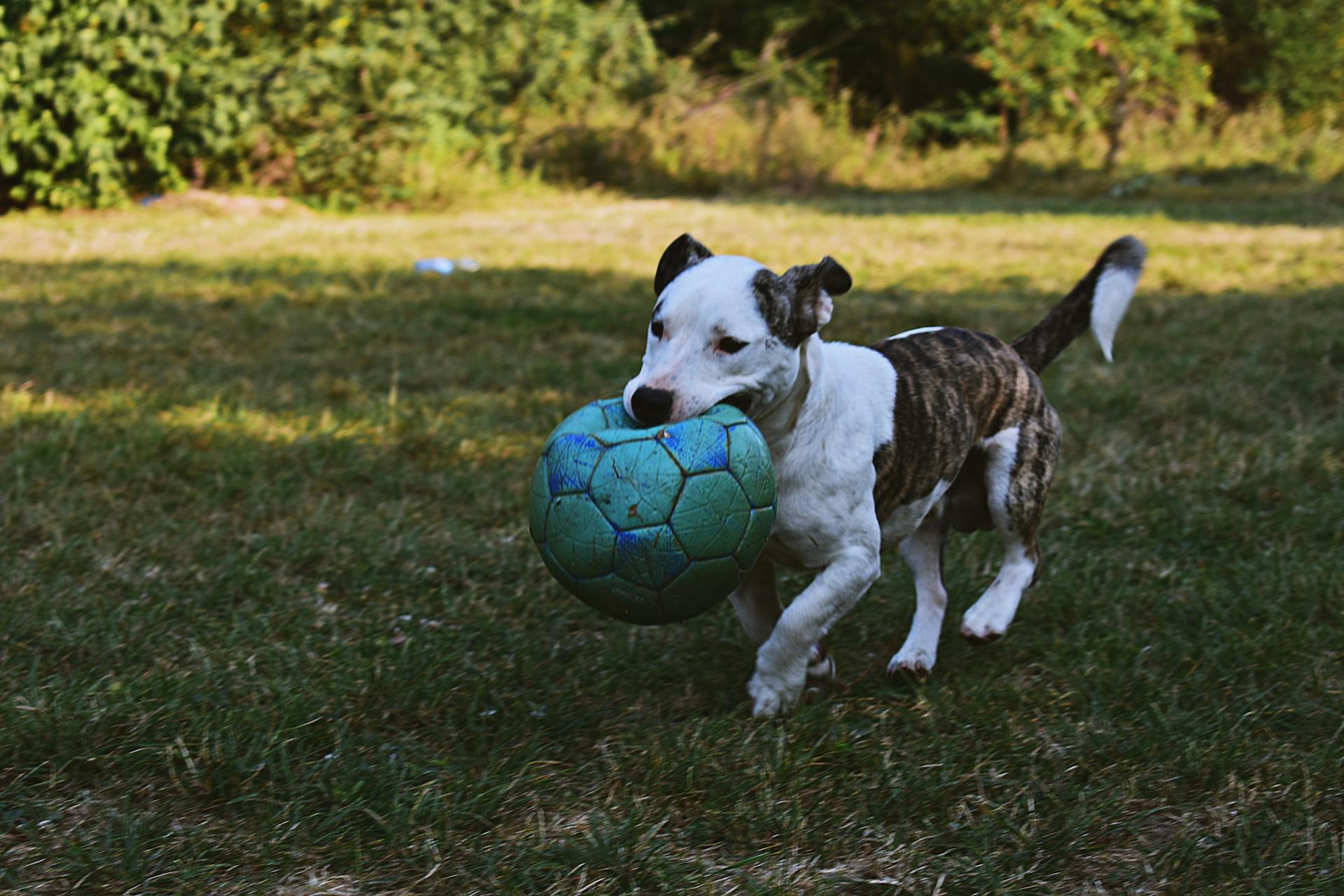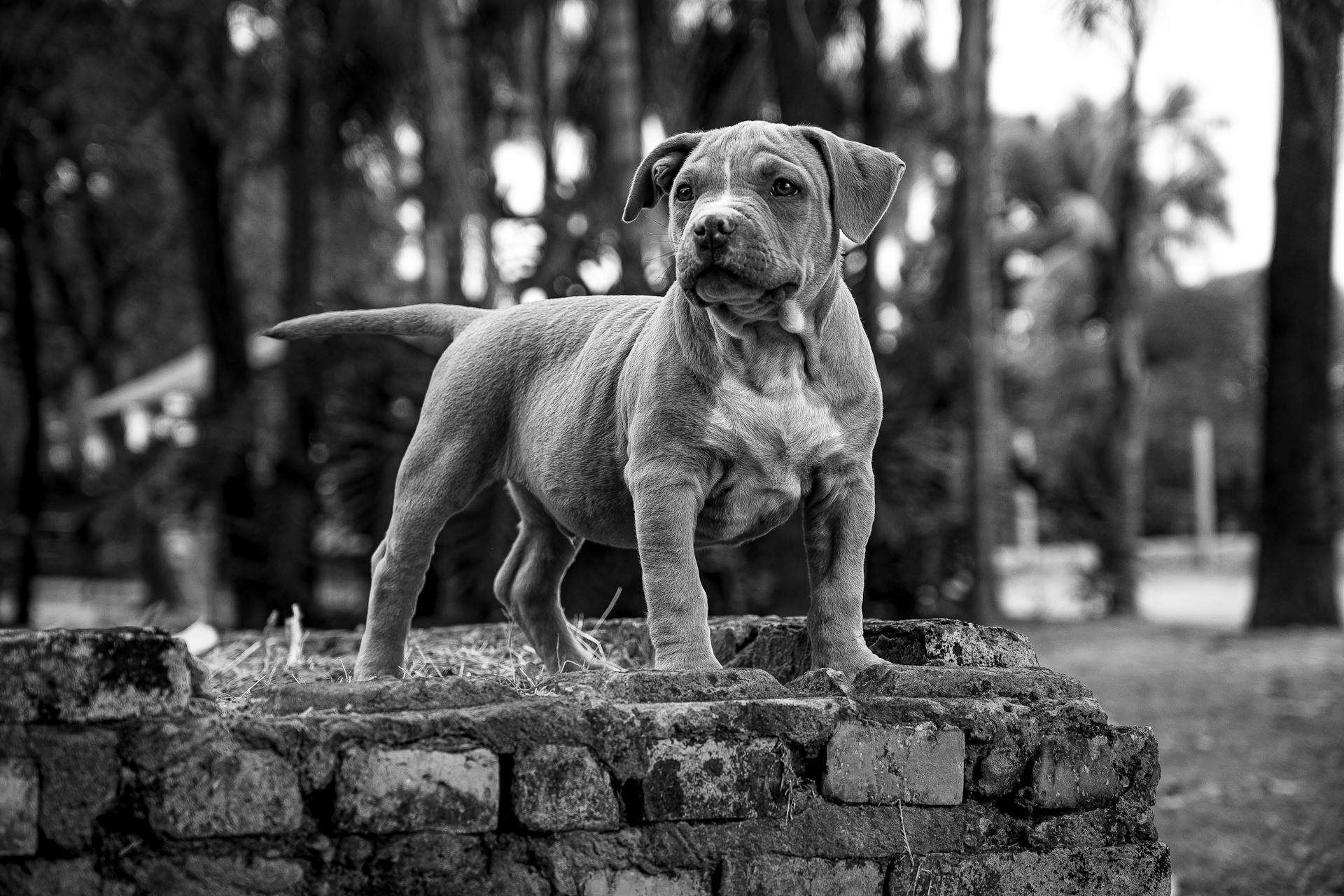
If your dog is a bully, it's essential to identify the signs early on to prevent any damage or harm.
Growling, snapping, or showing their teeth are all warning signs that your dog is feeling threatened or scared.
Dogs that are bullies often exhibit dominant body language, such as raising their hackles, lowering their head, or standing over their owners.
A bully dog may also show aggression towards other pets in the household, so it's crucial to keep a close eye on their behavior around others.
The 5 Signs
If your dog is always the one chasing, pinning, barking at, or grabbing other dogs, it might be a sign of bullying behavior.
Positive dog play involves give-and-take, but if your dog ignores this critical part of play, he might be pushy to the point of being a bully.
If your dog reacts aggressively when his playmate tries to tell him "no thank you", it's a red flag for bullying behavior.
Bullying dogs often pick a specific target and go after it relentlessly, ignoring the other dog's attempts to get away.
If your dog ignores signs from other dogs to back off, such as walking away, stopping eye contact, or snarling and growling, it could be a sign of bullying.
Bullying behavior can also manifest in stealing other dog's toys or food, especially if it's one-sided and the dog won't share or growls at other dogs.
If this caught your attention, see: Why Does My Male Dog Lick My Female Dog's Pee
Teaching Appropriate Behavior
Teaching your dog to stop bullying requires a keen eye and quick reflexes. It's best to work with your dog in a controlled environment, like a fenced yard, instead of in a park where the amount of open space and the opportunity for other dogs to intervene can delay the process.
To reform a bully dog, select a confident playmate that can tolerate canine misbehavior and won't get triggered by your dog's pushiness. Avoid dogs that are likely to become overwhelmed by the bully dog's behavior. The goal is to teach your dog that when he gets pushy with another dog, his fun time ends.
Use a verbal marker, such as "Time out" or "No thanks!", to capture the moment when your dog behaves inappropriately. Put your dog on a long, light leash before the play session begins to enforce the time-out without having to put your hand in between the dogs.
Recognize when the bullying behavior starts and stop it quickly, ideally before the other dog looks stressed or tries to get away. If your dog starts off by interacting politely with the other dog, praise him for his good behavior and allow them to continue playing.
A fresh viewpoint: What Can You Feed Dogs Other than Dog Food
Now That You Know: Teaching
Teaching your dog to behave appropriately requires patience and a controlled environment. It's best to work with your dog in a fenced yard instead of a park where other dogs can intervene.
Selecting the right playmate is crucial. Choose a confident dog that can tolerate your dog's misbehavior and won't get overwhelmed.
The goal is to teach your dog that pushy behavior ends the fun. You can use a verbal marker to capture the moment your dog behaves inappropriately, like "Time out" or "No thanks!" said in a neutral tone.

Putting your dog on a long, light leash, or "drag line", allows you to enforce time-outs without physical intervention. This is especially helpful when training a bully dog.
A confident playmate can help your dog learn that pushy behavior isn't tolerated. They can also provide a sense of security for your dog during the training process.
Modifying Behavior
Reforming a canine bully takes a keen eye and quick reflexes. It’s best to work with your dog in a controlled environment, like a fenced yard, instead of in a park where the amount of open space and the opportunity for other dogs to intervene can delay the process.
Select a confident playmate that can tolerate canine misbehavior and won’t get triggered by your dog’s pushiness. Avoid dogs that are likely to become overwhelmed by the bully dog’s behavior.
The goal of the exercise is to teach your dog that when he gets pushy with another dog, his fun time ends. You can employ a verbal marker to capture the moment when your dog has behaved inappropriately, something like “Time out” or “No thanks!” said in a neutral tone of voice.
Readers also liked: Canine Dysfunctional Behavior
Put your dog on a long, light leash before the play session begins, this “drag line” allows you to enforce the time-out without having to put your hand in between the dogs.
Some bullying dogs get to work immediately, while others take time to build to a fever pitch. If your dog starts off by interacting politely with the other dog, praise him for his good behavior and allow them to continue playing.
Occasionally call your dog to you during the session before things get out of hand for occasional “de-escalation” breaks, during which you praise him and give him a small treat. This allows your dog a few seconds to cool off, which might prevent the bullying from even starting.
The key to determining when play has tipped over from fun to fraught is watching the other dog. The moment the other dog looks stressed or like he’s trying to get away from your dog, use your time-out phrase to mark your dog’s behavioral infraction.
Saying the phrase without any consequence, or lagging between when you say it and when the time-out begins, will slow your progress and likely confuse your dog. With enough pairings of the phrase and the time-out, your dog should start to realize that every time he’s inappropriate with his playmate, the fun stops.
If your dog’s behavior continues to make the other dog uncomfortable after several time-outs, or it seems like the time-outs are not changing his behavior, you might have to wrap it up for the day.
What to Do If
If your child throws a tantrum in public, stay calm and try to distract them with a toy or a snack.
It's essential to set clear boundaries and consequences for misbehavior, as this helps children develop self-regulation skills.
If your child refuses to share with others, model sharing behavior yourself and explain to them that sharing is a way to show kindness and friendship.
You can also encourage your child to take turns and find ways to compromise, such as "we can take turns playing with the toy."
If your child is being bullied, listen to their concerns and reassure them that it's not their fault.
Remind them that they don't have to face the bully alone and that you're there to support them.
If your child is struggling with impulse control, teach them strategies like counting to 10 or taking a deep breath before acting on a impulse.
Check this out: Why Is My Female Dog Whining and Carrying a Toy
Common Bully Behaviors
If your dog is a bully, you might notice them constantly chasing, pinning, barking at, or grabbing other dogs. This behavior is a sign that your dog is not respecting the other dog's boundaries.
Positive dog play involves give-and-take, but a bully will often ignore the other dog's signals to back off. They might even escalate the interaction, ignoring the other dog's discomfort and continuing to pin, nip, or chase.
Some bullying dogs pick a specific target and go after it relentlessly, often a smaller or less confident dog. If the other dog looks like they're trying to get away, your dog is likely bullying them.
A bully dog will often get a kick out of tormenting less-assertive members of their playgroup, engaging in rough and harassing behavior with escalating frequency. They might even redirect their attention to a new target if the first one tells them to back off.
Your dog might be a bully if they're always the one initiating play and refusing to back off, even if the other dog is trying to signal that they're uncomfortable. This behavior can be a sign that your dog is not respecting the other dog's boundaries.
It's also possible that your dog is a bully if they're constantly stealing other dogs' toys or food, especially targeting less confident canines. This behavior is a sign that your dog is not willing to share or respect the other dog's possessions.
For your interest: What Dog Is the Target Dog
Preventing Bullying
If your dog is a bully, it's essential to intervene promptly when he's harassing another dog. This means stepping in before things escalate.
Watch your dog's playstyle closely, and ask yourself if he's always the one chasing, pinning, barking at, or grabbing other dogs. If so, he might be pushy to the point of being a bully.
A good playmate will take feedback from another dog to heart and back off, but a bully will ignore the other dog's signals and continue the intense interaction. This is a clear warning sign that your dog needs to learn some new play skills.
When your dog's playmate tries to tell him "no thank you", does he ignore the signal and continue the behavior? If so, it's a sign that your dog is a bully.
Intervene promptly when you see your dog being a bully, and work on teaching him more appropriate play skills. This might involve working with a professional trainer or practicing new behaviors with him.
By being aware of these signs and taking action early on, you can help prevent bullying behavior in your dog and create a more harmonious relationship with other dogs.
Sources
- https://www.petmd.com/dog/behavior/what-do-about-dog-bullies-other-dogs
- https://www.dogster.com/lifestyle/dog-bullying-other-dogs
- https://naturalcravingsusa.com/are-bully-sticks-digestible-everything-you-need-to-know-to-keep-your-dog-safe-l-natural-cravings-usa/
- https://www.whole-dog-journal.com/behavior/is-your-dog-a-bully/
- https://franklinhardwareandpetcenter.com/blog/48812/how-to-stop-your-dog-from-bullying-other-dogs
Featured Images: pexels.com


